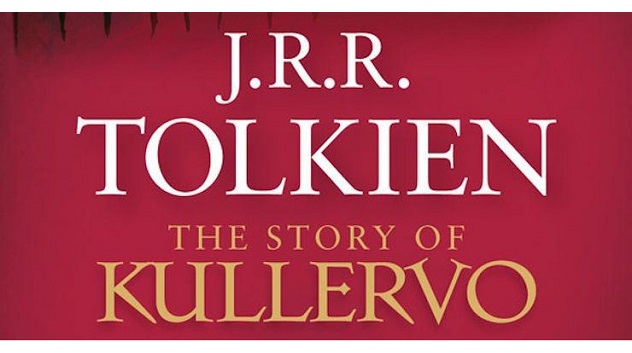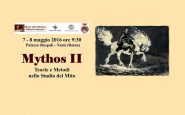« Indietro
In questi ultimi giorni mi sono imbattuta diverse volte nella notizia della prossima uscita di un libro inedito di J.R.R. Tolkien: The Story of Kullervo. Uscirà per l'editrice Harper Collins il prossimo 27 agosto in Gran Bretagna, mentre il pubblico americano dovrà aspettare fino alla fine di ottobre. Non si fa ancora menzione invece - nè sui quotidiani "cartacei" nè sul web - di traduzioni in italiano, quindi confidiamo o nella pazienza degli appassionati italiani di Tolkien o nella loro capacità di lettura in lingua originale.
In realtà, non si tratta propio di un inedito come la maggior parte dei media scrive nei titoli: ad esempio l'articolo di la Repubblica di venerdì 14 agosto titolava Miti e leggende finlandesi. Va in libreria un Tolkien inedito. E inizia come segue: Dopo aver trascorso un secolo in archivio, approda in libreria un inedito di J.R.R. Tolkien: il primo racconto dell'autore del Signore degli anelli, scritto quando era ancora studente ad Oxford, nel 1914. Alla fine del breve articolo viene riportato il fatto che il rinvenimento del manoscritto del giovane Tolkien è avvenuto nel 2009. La professoressa Verlyn Flieger, nota studiosa di J.R.R. Tolkien, trovò il manoscritto alla Oxford Bodleian Library: già nel 2010 lo trascrisse e lo pubblicò su Tolkien Studies.Volume 7, 2010, West Virginia University Press.
Effettivamente la signora Verlyn Flieger pubblica studi su Tolkien dal 2004: sono al momento 11 i volumi dei Tolkien Studies di cui Verlyn Fliger è editor insieme a Douglas A. Anderson e Michael D. C. Drout: "Tolkien Studies, a refereed journal dedicated to the scholarly study of the works of J. R. R. Tolkien. Tolkien Studies is the first academic journal solely devoted to Tolkien. As editors, our goal is to publish excellent scholarship on Tolkien as well as to gather useful research information, reviews, notes, and documents". (da Editor's Introduction Tolkien Studies Vol.1, 2004).
Nel Tolkien Studies.Volume 7, pp. 211-278, il contributo della professoressa Verlyn Flieger si intitola "The Story of Kullervo" and Essays on Kalevala:
It has long been known from Tolkien's own comments in his letters that that the Finnish mythology Kalevala had a powerful effect on his imagination and his legendarium. Just how powerful is strikingly apparent in "The Story of Kullervo" and the two drafts of "On the Kalevala," all three here published for the first time. Both the story and the essay provide substantial evidence of Tolkien's early enthusiasm for and desire to communicate the unfettered exuberance, the unspoiled pagan quality, and what he called the "delicious exaggerations" of what were to him "wild … uncivilized and primitive tales."
At the time Tolkien was writing, Elias Lönnrot's compilation of Finnish folk-ballads was a relatively recent addition to the world's mythological literature. Tolkien first discovered the Kalevala through Kirby's English translation in 1911, when he was at King Edward's School in Birmingham. When he went up to Oxford in the fall of that year, he checked out a Finnish grammar from the Exeter College Library hoping to read the Kalevala in the original, which hope was largely frustrated.
While working on his degree at Oxford in October of 1914 he wrote to his future wife (then fiancée) Edith Bratt that he was "trying to turn one of the stories [of the Kalevala]—which is really a very great story and most tragic—into a short story somewhat on the lines of Morris' romances with chunks of poetry in between" (Letters 7). Although he never finished it, Tolkien later gave this story credit as being "the original germ of the Silmarillion" [...]
The narrative trajectory of Tolkien's story follows Runos 31-36 in the Kalevala. [...]
Qui la lettura completa in Pdf
E' ovviamente Verlyn Fliger il curatore di The Story of Kullervo di prossima uscita in Gran Bretagna per la Harper Collins: di seguito la quarta di copertina
Kullervo son of Kalervo is perhaps the darkest and most tragic of all J.R.R. Tolkien’s characters. ‘Hapless Kullervo’, as Tolkien called him, is a luckless orphan boy with supernatural powers and a tragic destiny.
Brought up in the homestead of the dark magician Untamo, who killed his father, kidnapped his mother, and who tries three times to kill him when still a boy, Kullervo is alone save for the love of his twin sister, Wanona, and guarded by the magical powers of the black dog, Musti. When Kullervo is sold into slavery he swears revenge on the magician, but he will learn that even at the point of vengeance there is no escape from the cruellest of fates.
Tolkien himself said that The Story of Kullervo was ‘the germ of my attempt to write legends of my own’, and was ‘a major matter in the legends of the First Age’. Tolkien’s Kullervo is the clear ancestor of Túrin Turambar, tragic incestuous hero of The Silmarillion. In addition to it being a powerful story in its own right, The Story of Kullervo – published here for the first time with the author’s drafts, notes and lecture-essays on its source-work, The Kalevala – is a foundation stone in the structure of Tolkien’s invented world.
Tolkien, Flieger e La Storia di Kullervo
Il 18/08/2015
In questi ultimi giorni mi sono imbattuta diverse volte nella notizia della prossima uscita di un libro inedito di J.R.R. Tolkien: The Story of Kullervo. Uscirà per l'editrice Harper Collins il prossimo 27 agosto in Gran Bretagna, mentre il pubblico americano dovrà aspettare fino alla fine di ottobre. Non si fa ancora menzione invece - nè sui quotidiani "cartacei" nè sul web - di traduzioni in italiano, quindi confidiamo o nella pazienza degli appassionati italiani di Tolkien o nella loro capacità di lettura in lingua originale.
In realtà, non si tratta propio di un inedito come la maggior parte dei media scrive nei titoli: ad esempio l'articolo di la Repubblica di venerdì 14 agosto titolava Miti e leggende finlandesi. Va in libreria un Tolkien inedito. E inizia come segue: Dopo aver trascorso un secolo in archivio, approda in libreria un inedito di J.R.R. Tolkien: il primo racconto dell'autore del Signore degli anelli, scritto quando era ancora studente ad Oxford, nel 1914. Alla fine del breve articolo viene riportato il fatto che il rinvenimento del manoscritto del giovane Tolkien è avvenuto nel 2009. La professoressa Verlyn Flieger, nota studiosa di J.R.R. Tolkien, trovò il manoscritto alla Oxford Bodleian Library: già nel 2010 lo trascrisse e lo pubblicò su Tolkien Studies.Volume 7, 2010, West Virginia University Press.
Effettivamente la signora Verlyn Flieger pubblica studi su Tolkien dal 2004: sono al momento 11 i volumi dei Tolkien Studies di cui Verlyn Fliger è editor insieme a Douglas A. Anderson e Michael D. C. Drout: "Tolkien Studies, a refereed journal dedicated to the scholarly study of the works of J. R. R. Tolkien. Tolkien Studies is the first academic journal solely devoted to Tolkien. As editors, our goal is to publish excellent scholarship on Tolkien as well as to gather useful research information, reviews, notes, and documents". (da Editor's Introduction Tolkien Studies Vol.1, 2004).
Nel Tolkien Studies.Volume 7, pp. 211-278, il contributo della professoressa Verlyn Flieger si intitola "The Story of Kullervo" and Essays on Kalevala:
It has long been known from Tolkien's own comments in his letters that that the Finnish mythology Kalevala had a powerful effect on his imagination and his legendarium. Just how powerful is strikingly apparent in "The Story of Kullervo" and the two drafts of "On the Kalevala," all three here published for the first time. Both the story and the essay provide substantial evidence of Tolkien's early enthusiasm for and desire to communicate the unfettered exuberance, the unspoiled pagan quality, and what he called the "delicious exaggerations" of what were to him "wild … uncivilized and primitive tales."
At the time Tolkien was writing, Elias Lönnrot's compilation of Finnish folk-ballads was a relatively recent addition to the world's mythological literature. Tolkien first discovered the Kalevala through Kirby's English translation in 1911, when he was at King Edward's School in Birmingham. When he went up to Oxford in the fall of that year, he checked out a Finnish grammar from the Exeter College Library hoping to read the Kalevala in the original, which hope was largely frustrated.
While working on his degree at Oxford in October of 1914 he wrote to his future wife (then fiancée) Edith Bratt that he was "trying to turn one of the stories [of the Kalevala]—which is really a very great story and most tragic—into a short story somewhat on the lines of Morris' romances with chunks of poetry in between" (Letters 7). Although he never finished it, Tolkien later gave this story credit as being "the original germ of the Silmarillion" [...]
The narrative trajectory of Tolkien's story follows Runos 31-36 in the Kalevala. [...]
Qui la lettura completa in Pdf
E' ovviamente Verlyn Fliger il curatore di The Story of Kullervo di prossima uscita in Gran Bretagna per la Harper Collins: di seguito la quarta di copertina
Kullervo son of Kalervo is perhaps the darkest and most tragic of all J.R.R. Tolkien’s characters. ‘Hapless Kullervo’, as Tolkien called him, is a luckless orphan boy with supernatural powers and a tragic destiny.
Brought up in the homestead of the dark magician Untamo, who killed his father, kidnapped his mother, and who tries three times to kill him when still a boy, Kullervo is alone save for the love of his twin sister, Wanona, and guarded by the magical powers of the black dog, Musti. When Kullervo is sold into slavery he swears revenge on the magician, but he will learn that even at the point of vengeance there is no escape from the cruellest of fates.
Tolkien himself said that The Story of Kullervo was ‘the germ of my attempt to write legends of my own’, and was ‘a major matter in the legends of the First Age’. Tolkien’s Kullervo is the clear ancestor of Túrin Turambar, tragic incestuous hero of The Silmarillion. In addition to it being a powerful story in its own right, The Story of Kullervo – published here for the first time with the author’s drafts, notes and lecture-essays on its source-work, The Kalevala – is a foundation stone in the structure of Tolkien’s invented world.




